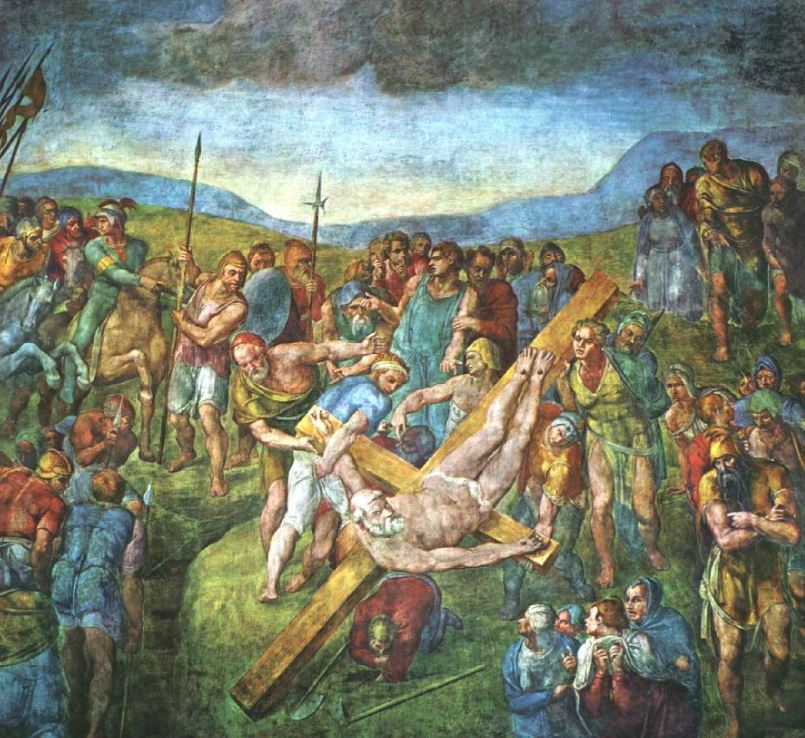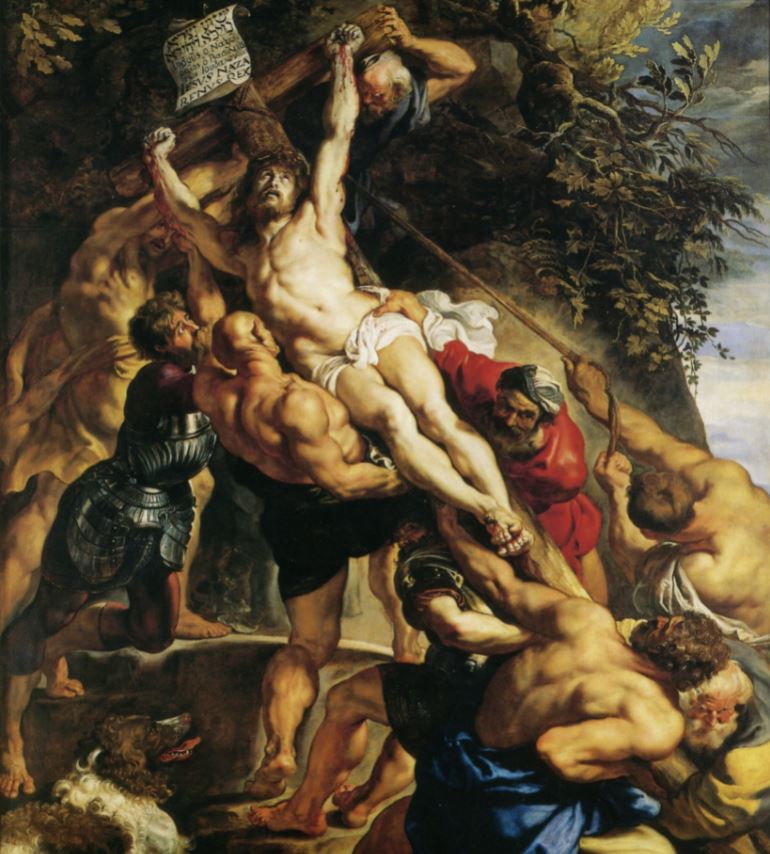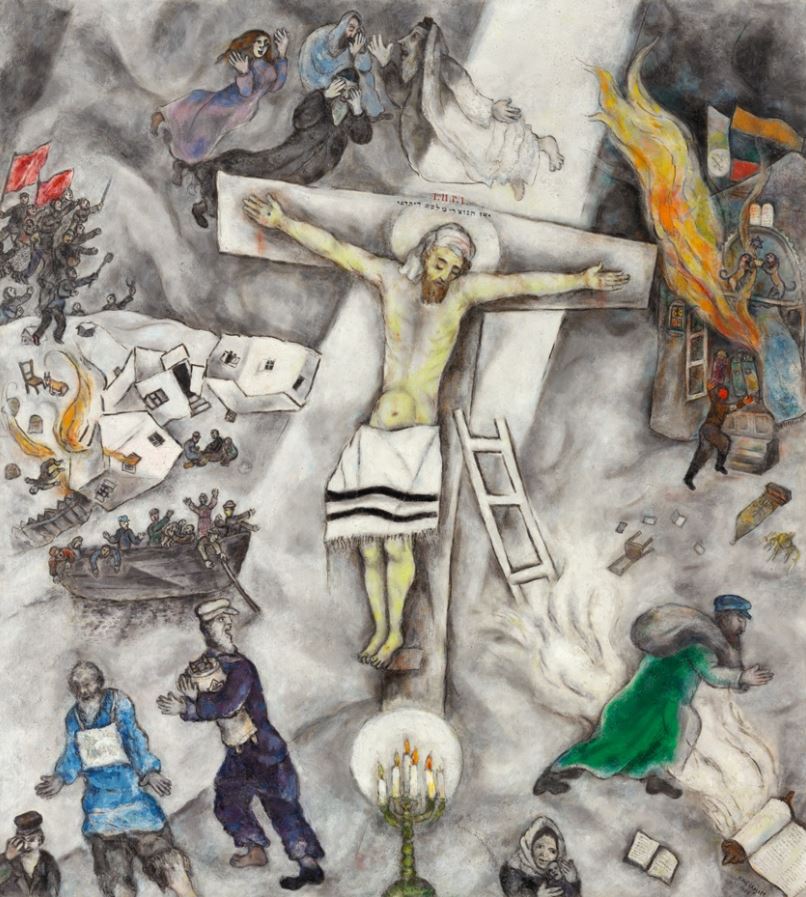Apart from Last Supper paintings and works depicting the Virgin Mary, paintings of the Crucifixion of Jesus Christ and other religious figures are the most-produced religious artworks in history.
This subject emerged in Byzantine art after the fall of the Western Roman Empire, during the Middle Ages, and all the way from the Renaissance to the modern era.
Because of this, Crucifixion paintings are great for seeing the progress of different art movements and how art evolved over the centuries.
In this article, we’ll take a closer look at some of the most famous Crucifixion paintings in history.
1. Berlin Crucifixion – Giotto
- Date created: 1320
- Dimensions: 58 × 33 centimeters (23 × 13 inches)
- Location: Gemäldegalerie, Berlin, Germany
The Berlin Crucifixion is the title of a painting by Giotto di Bondone (1267-1337), a Gothic artist who was heavily influenced by Byzantine art. He lived and worked in Florence, Italy during the late Middle Ages and produced some of the most famous Gothic artworks during this period.
The painting was completed using tempera and gold on a panel and is relatively small. This was a time in art history before oil painting became the standard medium so it significantly differs from Renaissance paintings. His style is sometimes referred to as “Proto-Renaissance” as well.

2. Crucifixion and Last Judgement diptych – Jan van Eyck
- Date created: 1430-1440
- Dimensions: 56.5 × 19.7 centimeters (22.25 × 7.75 inches)
- Location: MET Museum, New York City, United States
Crucifixion and Last Judgement diptych is a diptych painting by Jan van Eyck (1390-1441), the Early Netherlandish master who is credited as being one of the first painters to master oil painting. This is reflected in the incredible amount of detail he added to his works.
This diptych painting features a scene of the Crucifixion of Jesus Christ on the left and the Last Judgement and a hellscape on the right. It’s a diptych with hinges that can be closed and easily carried along and was most likely commissioned for devotional purposes.

3. Mond Crucifixion – Raphael
- Date created: 1502-1503
- Dimensions: 283.3 × 167.3 centimeters (111.5 × 65.9 inches)
- Location: National Gallery, London, United Kingdom
The Mond Crucifixion is also known as the “Gavari Altarpiece” and is a monumental work of art painted by Raphael (1483-1520), the master of the High Renaissance. It was one of the earliest works of the Italian artist and was completed when he was still a teenager (or in his early twenties).
What’s remarkable is that this work originally consisted of 4 panels of which only 3 have survived over the centuries. The central panel depicts the Crucifixion and was accompanied by a three-panel predella. It was commissioned to decorate a church near Raphael’s hometown of Urbino and it features a landscape that reflects this area.

4. The Crucifixion of Saint Peter – Michelangelo
- Date created: 1546-1550
- Dimensions: 625 × 662 centimeters (246 × 261 inches)
- Location: Cappella Paolina, Vatican Palace, Vatican City
The Crucifixion of Saint Peter is a monumental work of art by Michelangelo, the other famous Renaissance master of the 16th century. It decorates a wall at the Cappella Paolina which is part of the Apostolic Palace in Vatican City.
It was the final fresco that Michelangelo completed in his life, an artist who was mainly a sculptor during his long career. The fresco was deteriorating and completely restored in 2009. Remarkably, a self-portrait by Michelangelo in the top left corner of the work was uncovered during this project.

5. Crucifixion – Titian
- Date created: 1558
- Dimensions: 371 × 197 centimeters (146 × 78 inches)
- Location: Church of San Domenico, Ancona, Italy
Crucifixion is the title of a painting by Titian (1488-1576), one of the greatest Venetian artists in history. It was completed when the Italian artist was already approaching his seventies and was commissioned by a Venetian who lived in Ancona, a city in central Italy.
The painting is about life-sized and features Saint Mary and Saint John who are positioned at the foot of the cross. The kneeling figure has been identified as Saint Dominic. The monumental painting is still held at a sanctuary of the Church of San Domenico in Ancona today.

6. Crucifixion – Tintoretto
- Date created: 1565
- Dimensions: 536 × 1127 centimeters(211 in × 444 in)
- Location: Scuola Grande di San Rocco, Venice, Italy
The Crucifixion is a painting by Tintoretto (1518-1594), a man who didn’t shy away from producing monumental works of art. The Venetian Mannerist artist produced serval paintings for the Scuola Grande di San Rocco, a fraternity in the city that was established in 1478.
The entire composition is full of figures which makes it one of the most remarkable Crucifixion paintings ever completed. It covers an entire wall of the Sala dell’Albergo, one of the many opulent rooms inside this famous landmark in Venice.

7. Crucifixion of Saint Peter – Caravaggio
- Date created: 1601
- Dimensions: 230 × 175 centimeters (91 × 69 inches)
- Location: Santa Maria del Popolo, Rome, Italy
The Crucifixion of Saint Peter is a painting by Caravaggio (1571-1610) and one of the most famous works in the oeuvre of this renowned Baroque painter. It’s a very characteristic work by Caravaggio and incorporates the Tenenbrism style he perfected magnificently.
It’s one of the 3 large paintings that decorate the Cherisi Chapel at the Santa Maria del Popolo church in Rome. The Conversion of Saint Paul by Caravaggio is accompanied by the much more colorful Assumption of the Virgin Mary by Annibale Carracci.

8. The Elevation of the Cross – Peter Paul Rubens
- Date created: 1610-1611
- Dimensions: 462 × 341 centimeters (182 × 134 inches)
- Location: Cathedral of Our Lady, Antwerp, Belgium
The Elevation of the Cross is one of the best-known paintings by Peter Paul Rubens (1577-1640), the Flemish master who lived and worked in Antwerp for most of his career. It’s currently housed at the Cathedral of Our Lady, the most prominent building in Antwerp.
It’s one of 3 paintings by Rubens that you can find in the cathedral, the other ones being the Descent from the Cross and the Assumption of the Virgin Mary. Rubens’ Crucifixion painting is the epitome of the dramatic Baroque style he developed which was heavily influenced by his extended trip to Italy in the early 17th century.

9. The Yellow Christ – Paul Gauguin
- Date created: 1889
- Dimensions: 91.1 × 73.4 centimeters (35.9 × 28.9 inches)
- Location: Buffalo AKG Art Museum, Buffalo, United States
The Yellow Christ is a painting by Paul Gauguin (1848-1903, a French artist who only became a professional painter later in life. He completed this work during his stay in Pont-Aven, a small village in the Britany region of France. This had become an art colony in the late 19th century.
Gauguin was inspired by a crucifix in a local chapel which served as the model for this remarkably yellow painting. It depicts Jesus Christ who is Crucified in a Breton landscape with Breton women mourning and praying beside him. The yellow color was symbolic of the harsh life of peasants at the time in this part of France.

10. White Crucifixion – Marc Chagall
- Date created: 1938
- Dimensions: 154,62 × 140 centimeters (60.87 × 55 inches)
- Location: Art Institute of Chicago, Chicago, United States
The White Crucifixion is a painting by Marc Chagall (1887-1985), a Russian artist who spent most of his career living and working in France. It’s a painting that emphasizes both the suffering of Jesus Christ and of the Jewish people shortly before the outbreak of World War II.
Chagall managed to use the Crucifixion of Jesus Christ as a symbol for the acts of violence committed against the Jews. The artist was inspired to paint this work after a trip to Europe from his native Belarus, a country that was part of the Russian Empire at the time.



